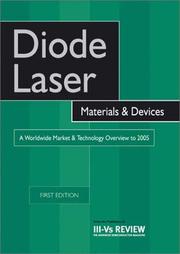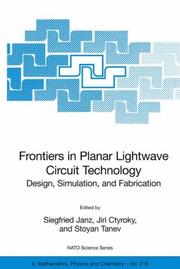| Listing 1 - 10 of 12 | << page >> |
Sort by
|
Periodical
Abstract | Keywords | Export | Availability | Bookmark
 Loading...
Loading...Choose an application
- Reference Manager
- EndNote
- RefWorks (Direct export to RefWorks)
Optical industry --- Photonics --- Optical industry. --- Photonics.
Periodical
Abstract | Keywords | Export | Availability | Bookmark
 Loading...
Loading...Choose an application
- Reference Manager
- EndNote
- RefWorks (Direct export to RefWorks)
Optical industry --- Photonics --- Optical industry. --- Photonics.
Periodical
Abstract | Keywords | Export | Availability | Bookmark
 Loading...
Loading...Choose an application
- Reference Manager
- EndNote
- RefWorks (Direct export to RefWorks)
Optical industry --- Photonics --- Optical industry. --- Photonics.
Book
Year: 1921 Publisher: Washington, : Government printing office,
Abstract | Keywords | Export | Availability | Bookmark
 Loading...
Loading...Choose an application
- Reference Manager
- EndNote
- RefWorks (Direct export to RefWorks)
Book
ISBN: 0819494836 Year: 2013 Publisher: Bellingham, Washington, USA : SPIE Press,
Abstract | Keywords | Export | Availability | Bookmark
 Loading...
Loading...Choose an application
- Reference Manager
- EndNote
- RefWorks (Direct export to RefWorks)
The goal of commercialization is to implement the key elements necessary to transform good technology into meaningful products that can fulfill customer needs while remaining cost effective. Specifically, can the technology be the basis for meeting a defined customer need? Can it be reproduced consistently, and can it be manufactured cost effectively? Most entrepreneurs have expertise in one or more of the critical areas of commercialization, but may lack key elements necessary for success. Commercialization Basics for the Photonics Industry serves as a roadmap for the commercialization process, helping identify and address roadblocks on the path to commercialization. Evaluation techniques will help determine the strength of a business opportunity and guide its development toward the best chance of success.
Optical industry. --- Technological innovations --- Advertising. --- Management. --- Marketing.

ISBN: 9780871692597 Year: 2007 Publisher: Philadelphia American philosophical society
Abstract | Keywords | Export | Availability | Bookmark
 Loading...
Loading...Choose an application
- Reference Manager
- EndNote
- RefWorks (Direct export to RefWorks)
Eyeglasses --- Optical industry --- Renaissance --- Vision disorders --- History --- Treatment
Book
ISBN: 9282553302 9789282553305 Year: 1985 Volume: vol *393 Publisher: Bruxelles: Commission des Communautés européennes,
Abstract | Keywords | Export | Availability | Bookmark
 Loading...
Loading...Choose an application
- Reference Manager
- EndNote
- RefWorks (Direct export to RefWorks)
Optical industry --- -Optical instrument industry --- Instrument industry --- -Optical industry --- Optical instrument industry --- Optische industrie. Euromarkt. --- Matériaux optiques. Marché commun européen. --- Industrie optique. Marché commun européen. --- Optische materialen. Euromarkt. --- Optical industry - European Economic Community countries

ISBN: 1281048070 9786611048075 0080530435 1856173860 9781856173865 9780080530437 9781281048073 6611048073 Year: 2001 Publisher: Oxford : Elsevier Advanced Technology,
Abstract | Keywords | Export | Availability | Bookmark
 Loading...
Loading...Choose an application
- Reference Manager
- EndNote
- RefWorks (Direct export to RefWorks)
This report examines the development of the diode laser industry over a six-year period, 2000 to 2005, incorporating analysis of trends in markets, technologies and industry structure. It is designed to provide key information to users and manufacturers of substrates, epitaxial wafers (epiwafers) and devices.The coverage includes components, laser diodes, and the semiconducting (SC) wafers and epiwafers on which most of these devices are made. The geographical coverage of the report includes North America, Japan and Europe, which together will account for over 90% of the production
Semiconductor lasers. --- Diodes, Semiconductor. --- Laser industry. --- Laser-using industries --- Optical industry --- Crystal diodes --- Diodes, Crystal --- Semiconductor diodes --- Semiconductors --- Lasers
Book
ISBN: 0585076480 9780585076485 1438421184 9781438421186 Year: 1992 Publisher: Albany, NY State University of New York Press
Abstract | Keywords | Export | Availability | Bookmark
 Loading...
Loading...Choose an application
- Reference Manager
- EndNote
- RefWorks (Direct export to RefWorks)
Optoelectronics industry --- Laser industry --- Fiber optics industry --- Image processing equipment industry --- Computer industry --- Photonics --- New optics --- Optics --- Electronic industries --- Laser-using industries --- Optical industry --- Government policy --- Industrial applications --- Research


ISBN: 1402041659 1402041640 1402041675 9786610413560 1280413565 Year: 2006 Volume: 216 Publisher: Brussels Dordrecht Nato Public Diplomacy Division Springer
Abstract | Keywords | Export | Availability | Bookmark
 Loading...
Loading...Choose an application
- Reference Manager
- EndNote
- RefWorks (Direct export to RefWorks)
This book is the result of the NATO Advanced Research Workshop on Frontiers in Planar Lightwave Circuit Technology, which took place in Ottawa, Canada from September 21-25, 2004. Many of the world’s leading experts in integrated photonic design, theory and experiment were invited to give lectures in their fields of expertise, and participate in discussions on current research and applications, as well as the new directions planar lightwave circuit technology is evolving towards. The sum of their contributions to this book constitutes an excellent record of many key issues and scientific problems in planar lightwave circuit research at the time of writing. In this volume the reader will find detailed overviews of experimental and theoretical work in high index contrast waveguide systems, micro-optical resonators, nonlinear optics, and advanced optical simulation methods, as well as articles describing emerging applications of integrated optics for medical and biological applications. vii Acknowledgements We would like to acknowledge and express our gratitude to the several organizations whose support and involvement made this NATO Advanced Research Workshop possible. This workshop was of course made possible because of the initial financial grant awarded by the NATO Security through Science Programme in Brussels, Belgium. We also acknowledge the Canadian Institute for Photonic Innovation (CIPI), the Canadian Photonics Fabrication Center and the National Research Council Canada, the Center for Research in Photonics at the University of Ottawa, Carleton University, Optiwave Systems Inc. and the Canadian Microelectronic Center for their generous support and/or cooperation.
Optics --- Optique --- Congresses. --- Congrès --- Optical industry. --- Optics -- Congresses. --- Optics -- Periodicals. --- Optics. --- Physics --- Physical Sciences & Mathematics --- Light & Optics --- Optical communications --- Light --- Design and construction --- Wave-length --- Congrès --- EPUB-LIV-FT LIVPHYSI SPRINGER-B --- Communications, Optical --- Light communications --- Physics. --- Quantum optics. --- Microwaves. --- Optical engineering. --- Ecotoxicology. --- Optics, Lasers, Photonics, Optical Devices. --- Quantum Optics. --- Microwaves, RF and Optical Engineering. --- Electromagnetic waves --- Light sources --- Spectrum analysis --- Photonics --- Telecommunication --- Congresses --- Environmental toxicology. --- Hertzian waves --- Electric waves --- Geomagnetic micropulsations --- Radio waves --- Shortwave radio --- Ecotoxicology --- Pollutants --- Pollution --- Environmental health --- Toxicology --- Lasers. --- Photonics. --- Mechanical engineering --- Photons --- Quantum theory --- New optics --- Light amplification by stimulated emission of radiation --- Masers, Optical --- Optical masers --- Light amplifiers --- Optoelectronic devices --- Nonlinear optics --- Optical parametric oscillators --- Planar lightwave --- Circuit technology
| Listing 1 - 10 of 12 | << page >> |
Sort by
|

 Search
Search Feedback
Feedback About UniCat
About UniCat  Help
Help News
News